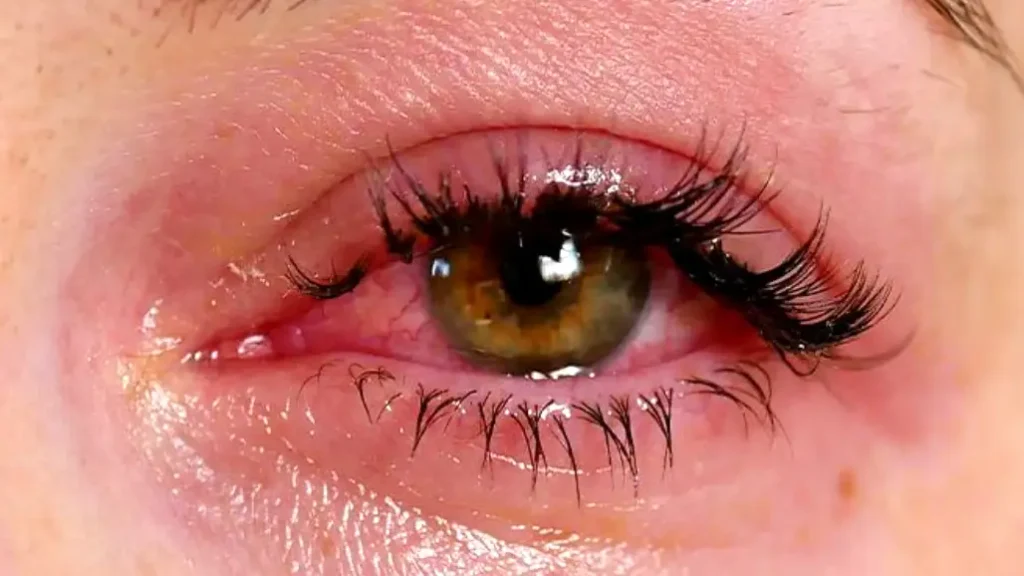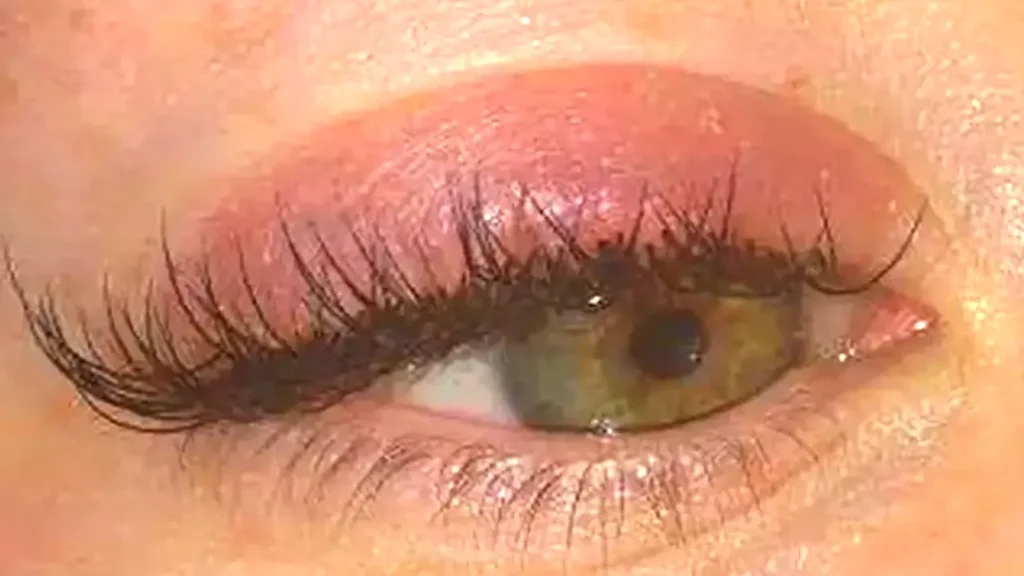![]()
Lash extensions can enhance your beauty and boost your confidence, but for some, the dream of long, luscious lashes can turn into a nightmare. Allergic reactions to lash extensions are a real concern, and understanding the potential causes and preventative measures is crucial for a safe and enjoyable lash experience.
This blog post will delve into the common causes of allergic reactions to lash extensions, explore the symptoms to watch out for, and provide valuable tips on how to prevent and manage these reactions. By understanding the potential risks and taking necessary precautions, you can enjoy the beauty of lash extensions safely and confidently.
Allergic Reaction to Lash Extensions

While generally safe, allergic reactions to eyelash extensions can occur. These reactions happen when the body’s immune system mistakenly identifies a component of the extension process as a foreign substance. This triggers an immune response, leading to various unpleasant symptoms.
The most common culprit behind these allergic reactions is the adhesive used to bond the extensions to natural lashes. These adhesives typically contain cyanoacrylates, powerful bonding agents that can irritate sensitive eyes.
Some individuals may also experience allergic reactions to the pigments used to dye the extensions or even the materials used to create the extensions themselves, such as certain types of synthetic fibers or mink.
Symptoms of an allergic reaction to lash extensions can vary in severity. Mild reactions may include:
- Itching and redness around the eyes.
- Watery eyes and increased tear production.
- Mild swelling of the eyelids.
- A slight burning or stinging sensation around the eyes.
More severe reactions can manifest as:
- Severe itching and swelling of the eyelids.
- Redness and inflammation of the conjunctiva (the thin membrane covering the white part of the eye).
- Blurred vision due to excessive swelling.
- Difficulty opening the eyes due to swelling and discomfort.
If you suspect an allergic reaction, it’s crucial to remove the extensions immediately. Gently cleanse the area around the eyes with a mild, oil-free cleanser. You can also apply cold compresses to reduce swelling and soothe irritation. If symptoms persist or worsen, consult an ophthalmologist or dermatologist for proper diagnosis and treatment.
Common allergic reaction to lash extensions symptoms
| Allergen | Symptoms |
|---|---|
| Cyanoacrylate (in adhesives) | Itching, eye redness after lash extensions, swelling, burning, stinging |
| Dyes | Redness, irritation, potential for contact dermatitis |
| Certain Synthetic Fibers | Itching, irritation, potential for allergic contact dermatitis |
| Mink (in some cases) | Itching, redness, potential for allergic reactions in individuals sensitive to animal proteins |
How to Know if You’re Allergic to Lash Extensions
Knowing if you’re allergic to lash extensions can be tricky as reactions can vary in severity and timing. Common signs of an allergic reaction include:
- Eye irritation: This can manifest as redness, itching, burning, stinging, or excessive tearing.
- Swelling: You might experience swelling around the eyelids, which can make it difficult to open your eyes.
- Discharge: Increased mucus or pus discharge from the eyes is another potential sign.
- Skin reactions: In some cases, you may experience a rash or skin irritation around the eyes.
If you experience any of these symptoms after getting lash extensions, it’s crucial to remove them immediately and consult with an ophthalmologist or dermatologist. They can properly diagnose the cause of your symptoms and recommend appropriate treatment.
Can I Still Get Lash Extensions if I’m Allergic
If you’ve experienced an allergic reaction to eyelash extensions, it’s generally not recommended to get them again. This is because your immune system has already recognized the adhesive or other components of the extensions as a foreign substance and will likely react again upon re-exposure.
While some people may be able to tolerate different types of adhesives or extensions, the risk of another reaction is significant. Repeated exposure can also worsen the severity of the reaction.
If you’re considering lash extensions despite a previous allergic reaction, it’s crucial to consult with an experienced lash artist and potentially an allergist. They can advise you on the risks involved and discuss potential alternatives, such as hypoallergenic adhesives or different types of extensions.
How to Prevent Allergic Reaction to Lash Extensions

Preventing allergic reactions to eyelash extensions involves a multi-faceted approach that prioritizes safety and minimizes potential irritants.
1. The Patch Test: A Crucial First Step
- What it is: A patch test involves applying a small amount of the adhesive used for the extensions to a discreet area of your skin, such as behind the ear or on the inner arm.
- Why it’s important: This allows you to observe any signs of an allergic reaction, such as redness, itching, or swelling, within 24-48 hours.
- When to do it: Ideally, a patch test should be conducted 24-48 hours before your lash extension appointment.
2. Choosing Hypoallergenic Lash Extenisions
- Opt for hypoallergenic lash extension glue: These adhesives are specifically formulated to be less irritating and are less likely to trigger an allergic reaction.
- Look for adhesives with fewer harsh chemicals: Some adhesives contain fewer harsh chemicals and are more gentle on the eyes. Opt for adhesives specifically formulated to be hypoallergenic and low-irritating. These adhesives may contain fewer harsh chemicals and are less likely to trigger an allergic reaction.
- Extensions: Inquire about the materials used to create the extensions. Some individuals may be sensitive to certain types of synthetic fibers or even natural materials like mink.
3. Communication is Key
- Disclose Sensitivities: Before your appointment, inform your lash artist about any known allergies or sensitivities you may have, including allergies to adhesives, dyes, certain materials, or even latex.
- Ask Questions: Don’t hesitate to ask your lash artist about the products they use, their experience with sensitive clients, and their hygiene practices.
4. Prioritize Hygiene and Safety
- Choose a Reputable Salon: Select a salon with a clean and well-ventilated environment.
- Experienced Professionals: Ensure that your lash artist is properly trained and experienced in applying lash extensions safely and hygienically.
- Observe Hygiene Practices: Pay attention to the cleanliness of the tools and the overall hygiene practices of the salon.
5. Aftercare Matters
- Avoid Oil: Oil-based products can weaken the adhesive bond and increase the risk of irritation. Use oil-free cleansers, makeup removers, and moisturizers.
- Gentle Cleansing: Gently cleanse your lashes daily with a lash cleanser or a mild, oil-free soap. Avoid rubbing or scrubbing.
- Minimize Touching: Resist the urge to touch, rub, or pick at your extensions.
By following these preventative measures and communicating openly with your lash artist, you can significantly reduce the risk of an allergic reaction and enjoy the beauty of lash extensions safely and comfortably.
How to Treat Lash Extension Allergy
This is for informational purposes only. For medical advice or diagnosis, consult a professional.
If you suspect an allergic reaction to eyelash extensions, it’s crucial to take immediate steps to alleviate discomfort and prevent further irritation.
Remove the Extensions: The first and most important step is to remove the lash extensions as soon as possible. If you’re unsure how to do this safely, consult with a qualified lash artist or a dermatologist.
Cleanse Gently: Wash your eyes thoroughly with a gentle, oil-free cleanser. Avoid rubbing or scrubbing, as this can further irritate the eyes.
Cold Compresses: Apply cold compresses to the affected area for 15-20 minutes at a time, several times a day. This can help reduce swelling and soothe irritation.
Over-the-counter Medications:
- Antihistamines: Oral antihistamines like cetirizine (Zyrtec) or loratadine (Claritin) can help relieve itching, redness, and swelling.
- Artificial Tears: Lubricating eye drops can help soothe irritated eyes and provide relief from dryness.
If symptoms persist or worsen, consult with an ophthalmologist or dermatologist. They can properly diagnose the reaction and recommend appropriate treatment options, which may include:
- Topical corticosteroids: To reduce inflammation.
- Antibiotic eye drops: If a secondary bacterial infection occurs.
Conclusion
In conclusion, allergic reactions to lash extensions are possible but relatively uncommon. Identifying potential allergens, such as adhesives, dyes, or even certain lash materials, is crucial for prevention. Choosing hypoallergenic products and undergoing a patch test before a full set can significantly reduce the risk of adverse reactions. Communicating any concerns or sensitivities with your lash artist to ensure a safe and enjoyable lash extension experience is essential.
At HeyMe Beauty, we prioritize safety and quality in all our lash extension products. Our rated lash extensions are meticulously crafted using hypoallergenic materials and undergo rigorous quality control to minimize the risk of allergic reactions. We offer a wide range of options, including mink, silk, and synthetic fibers, to suit various sensitivities and preferences.
Ready to provide your clients with safe and beautiful lash extensions? Explore our collection of high-quality, rated lash extensions today. Contact us now to learn more about our lash extensions and place your order. We are committed to providing you with the best possible eyelashes extensions and support for your lash business.
